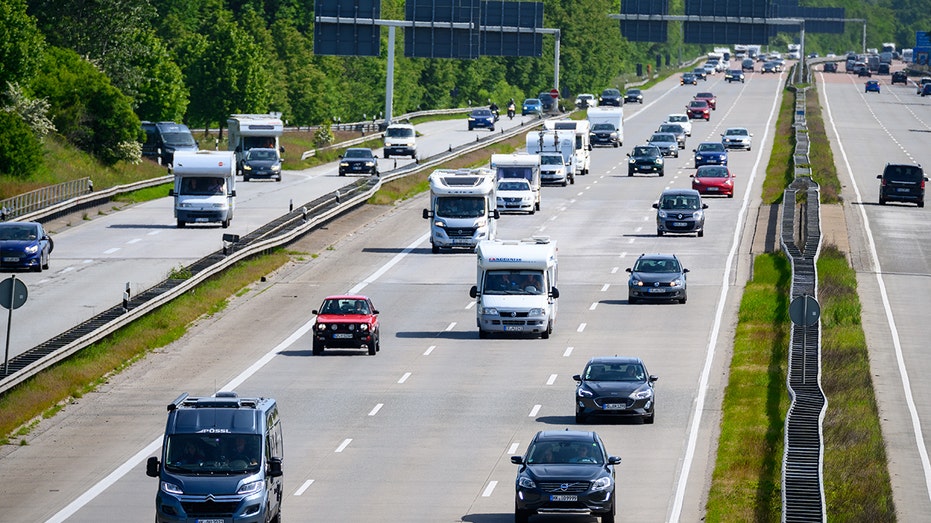Automakers call for 'practically impossible' automatic emergency braking rule to be reconsidered
Auto industry trade group says NHTSA automatic emergency braking rule is 'practically impossible'
Uber to be beneficiary of autonomous car rollout: Mahaney
Evercore ISI senior managing director Mark Mahaney explains why Uber is one of his top four large-cap stock picks on "Varney & Co."
A trade group representing major automakers on Monday called for the National Highway Traffic Safety Administration (NHTSA) to reconsider a new regulation issued this past spring that requires nearly all new cars and trucks to have advanced automatic emergency braking systems by 2029.
The Alliance for Automotive Innovation, which represents Ford, General Motors, Stellantis, Toyota and nearly all leading automakers, wrote to NHTSA and the leadership of congressional transportation committees informing them that the group filed a petition for the automatic emergency braking rule to be reconsidered.
| Ticker | Security | Last | Change | Change % |
|---|---|---|---|---|
| F | FORD MOTOR CO. | 13.46 | +0.15 | +1.13% |
| GM | GENERAL MOTORS CO. | 82.31 | +1.14 | +1.40% |
| STLA | STELLANTIS NV | 11.54 | -0.10 | -0.82% |
| TM | TOYOTA MOTOR CORP. | 219.25 | +3.07 | +1.42% |
The group argues that the regulation, which was adopted in April and would require all cars and trucks to be able to stop and avoid hitting vehicles in front of them while moving at speeds of up to 62 mph, is "practically impossible with available technology."
The NHTSA rule came in response to direction by Congress, which included a provision in the 2021 infrastructure law that directed the agency to develop a regulation establishing minimum performance standards for automatic emergency braking (AEB) systems. AEB uses sensors like cameras and radar to detect when a vehicle is close to crashing and automatically applies the brakes if the driver hasn't done so.
BUGATTI UNVEILS NEW SPORTS CAR WITH 1,800 HORSEPOWER AND A $4M PRICE TAG

A trade group representing leading automakers is pushing for the NHTSA to reconsider a regulation that requires nearly all new cars and trucks to have advanced automatic emergency braking systems by 2029. (Jonas Walzberg/picture alliance via Getty Images)
The trade group said NHTSA's requirements at higher driving speeds will result in vehicles "automatically applying the brakes far in advance of what a typical driver and others on the road would expect" and would likely result in rear-end collisions.
It also argued that NHTSA "vastly underestimated the necessary and costly hardware and software change required for vehicles to comply with the rule (something that will increase the cost of vehicles for consumers)."
FORD ANNOUNCES NEW BRONCO OFF-ROAD DRIVING SCHOOL IN TENNESSEE

Automakers argued that the NHTSA should adopt a different emergency braking standard that's currently in use in Europe. (Silas Stein/picture alliance via Getty Images)
Alliance for Automotive Innovation CEO John Bozzella said in the letter to Congress that the rule "will require more costly systems that won't improve driver or pedestrian safety."
"Here's what I (regrettably) conclude will happen: driving AEB equipped vehicles in the U.S. under NHTSA's new standard will become unpredictable, erratic and will frustrate or flummox drivers," Bozzella wrote.
"Yes, this rule will make vehicles more expensive, but the real issue isn't cost – it's cost/benefit. NHTSA's action will require more costly systems that won't improve driver or pedestrian safety, which is why we are asking the agency to reopen the proceeding and make these necessary corrections," he added.
AUTO DEALERSHIP OWNER REELING AFTER CDK GLOBAL SOFTWARE OUTAGE WREAKS HAVOC

The automatic emergency braking rule would apply to all new cars and trucks starting in 2029. (Brittany Murray/MediaNews Group/Long Beach Press-Telegram via Getty Images)
The trade group suggested that NHTSA should instead "adopt a standard already in place in Europe that detects a potential forward collision, provides a driver warning and automatically engages the braking system to avoid a collision – or mitigate its severity – through the use of existing crashworthiness systems designed to better protect road users."
NHTSA said in April that the rule will save at least 360 lives annually and prevent at least 24,000 injuries due to traffic accidents.
GET FOX BUSINESS ON THE GO BY CLICKING HERE
The agency released its first set of projections for traffic fatalities in 2024 on Monday, which estimated that 8,650 people died in traffic crashes in the first three months of the year – a decrease of about 3.2% from the 8,935 estimated fatalities in the same period in 2023. That figure marks the eighth consecutive quarterly decline in traffic fatalities dating to the second quarter of 2022.
The rule requires the AEB to apply brakes automatically up to 90 mph when a collision with a lead vehicle is imminent and up to 45 mph when a pedestrian is detected.
Reuters contributed to this report.




















